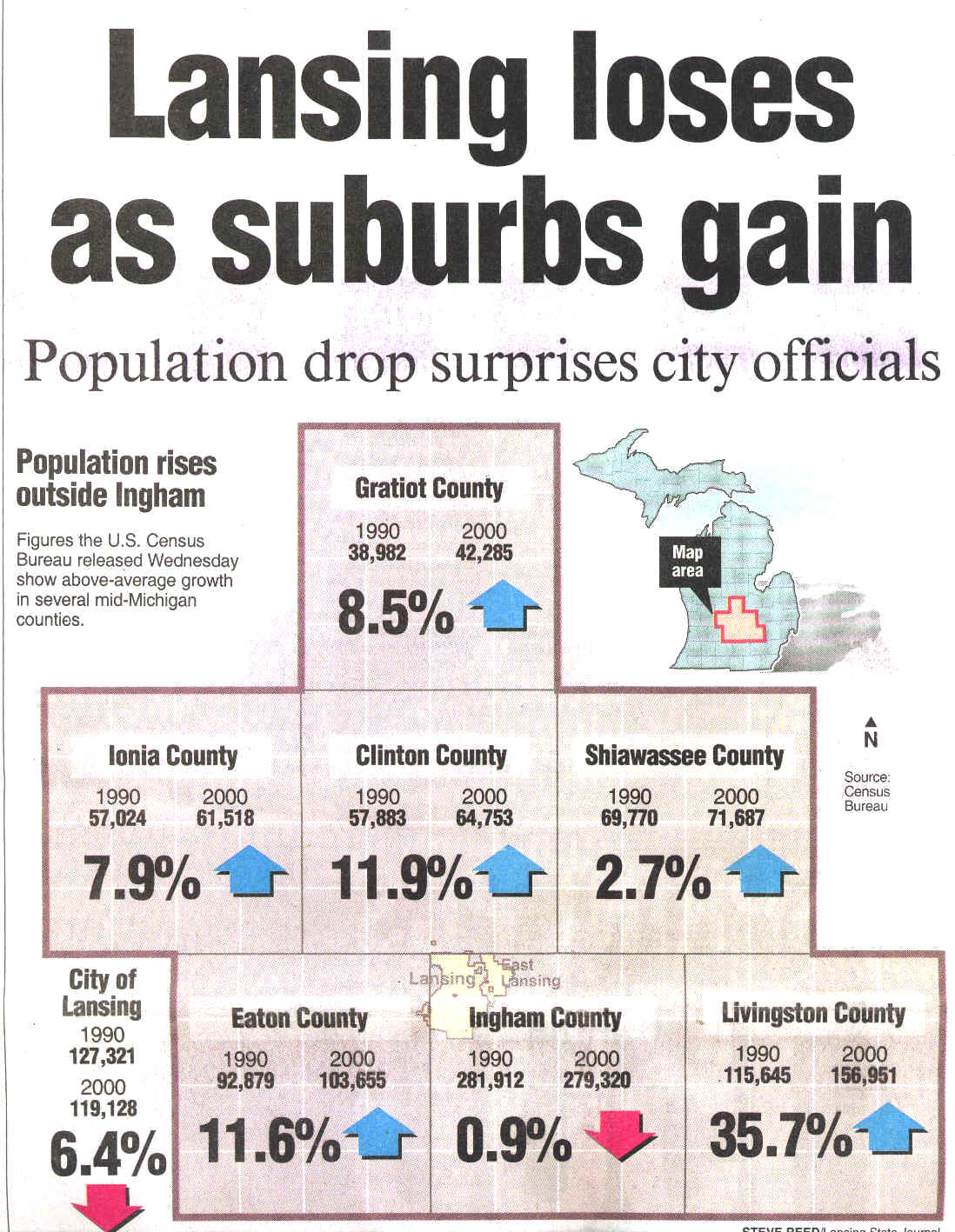In the late 1800's, with the birth of the auto and the Industrial Revolution, the trend moved from a predominantly rural population to a mostly urban one. By 1930, 68% of the population was urban, compared to 68% rural 50 years earlier. By the 1970's the trend was toward an urban exodus and a move to the suburbs. This urban-to-rural trend (suburbs are essentially rural) was facilitated by affordable automobiles, cheap gas, cheap rural land, better salaries at factories, and improving road conditions, as well as manufacturing firms that were relocating to the suburbs. The urban growth in the late 1800's was fueled more by immigrants moving into Michigan’s cities directly, than it was by in-state people relocating to cities. The urban to rural migration has been termed the "rural renaissance".
History of Urban Sprawl
Adjustment to the urban frontier was still incomplete when the movement outward from the central cities into the suburbs began. This exodus form established urban communities into open country on the fringe was at first residential, but subsequently became commercial and industrial as well. The movement had its origin in the extension of electric street railways beyond city limits in the early 1900's and was accentuated by the electric interurban, which made daily travel into the central city and back to the suburbs practicable. The movement continued after buses replaced the electric trolleys and interurbans, and reached its high point after World War II, when prolonged prosperity enabled almost every family to have one or more automobiles. In the 1950's, the urban fringe population within urbanized areas in Michigan more than doubled; the proportion of the state's population living in these areas increased from 16% in 1950 to almost 30% in 1960. In the same ten-year period, the proportion living in central cities of over 50,000 dropped from 40% to less than 33%. The first suburbanites were pioneers in many of the same ways as the farmers who came in the 1830's. Land acquisition was a matter of prime importance; transportation was a vital matter; provision for the necessities of life (such as water, supplies, waste disposal, fire protection and police protection in the case of the suburbanite) involved difficult problems; new governmental agencies had to be devised; schools and churches had to be built. And if those who departed from the central cities had problems, so did the central cities themselves: loss of business in the down-town areas, expensive street-widening, freeways, and parking projects to lure the shopper back down-town, the decay of residential areas vacated by those moving to the suburbs and occupied by low-income groups, a declining tax base, and many others.

A 2001 headline in the Lansing State Journal
The suburban frontier brought a new kind of population distribution. Within the suburbs themselves, the population was predominantly middle-class, white and Republican; within the central cities, unskilled laborers, African-Americans, people of foreign stock, and Democrats were much more numerous. Less than 12% of the non-white population of Michigan in 1960 lived in the urban fringe; almost 80% lived within the central cities.
Michigan's cities will be vastly different in the future. They will be
more "spread out", suburbs will be larger than the city, etc. Below are
some looks back at how our cities have changed to date, and how they are likely to change
in the next 20-30 years. First of all, we are likely to see more "open"
types of cities. Lower densities are likely to occur within suburbs, as everyone
wants their "space". Note the low densities expected for future suburbs
(below).
Michigan's communities used to be one central built-up area, surrounded by farmland and
patches of forest. Perhaps you still know of a small town somewhere in the state
that has this structure...Okemos and East Lansing once did!
This "placemat" map and the two directly below were produced by
the Michigan Geographic Alliance and the Science/Mathematics/Technology Center, Central
Michigan University, with funding from the U.S. Dept. of Education. For further
information email Wayne.E.Kiefer@cmich.edu
Contemporary Michigan communities more often resemble the structure seen below.
Development "corridors" exist along major traffic arteries into and out of
town. Houses spring up in nearby rural areas, on large lots, destroying valuable
farmland as they grow. Factories, schools and malls are built at the edges of the
cities, further accelerating suburban sprawl.
Suburbs will continue to grow, while the city center does not.
Source:
Michigan Society of Planning
Officials. 1995. Jobs and the Built Environment Trends. Working
Paper, Michigan�s Trend Future. Michigan Society of Planning Officials, Rochester,
MI.
Source: Michigan Society of Planning Officials. 1995. Jobs and the Built Environment Trends. Working Paper, Michigan�s Trend Future. Michigan Society of Planning Officials, Rochester, MI.
In a nutshell, the conversion of rural lands to suburban is shown below.
Source: Michigan Society of Planning Officials. 1995. Jobs and the Built Environment Trends. Working Paper, Michigan�s Trend Future. Michigan Society of Planning Officials, Rochester, MI.
This material has been compiled for educational use only, and may not be reproduced without permission. One copy may be printed for personal use. Please contact Randall Schaetzl (soils@msu.edu) for more information or permissions.